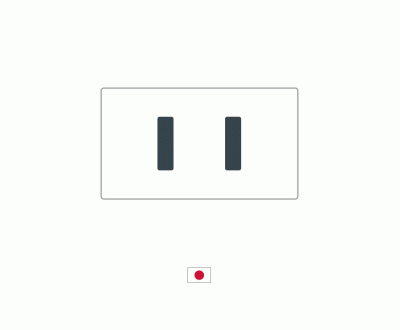Electric plugs in Japan and adapters
It is often a aspect which tends to be forgotten, because it seems more important for long-stay travelers. Yet, even short-stay travellers are concerned by the problematic of electric plugs. And the question works both ways:
- to use your own daily object while travelling on the archipelago;
- to bring back home Japanese items.
Types of plugs, volts and hertz (voltage and frequency)
Japanese plugs are type A plugs: flat and parallel electrical plugs, close to those in the US.
All different countries in the world do not use the same voltage. While Europe fluctuates between 220 and 240 volts, Japan is rather around 100 to 130V, just like USA.
Nowadays, a lot of electrical devices of all sorts (smartphones 📱, cameras 📷, computers…) have a very high voltage range : it is not rare to read on one of these products the "100V~240V" mention, meaning it will be suitable everywhere in the world without electrical transformer (see below), but only with a simple adapter for wall plug.
Regarding Hertz, it is a little more complicated on the archipelago: Tokyo and North of Japan are in 50Hz (like Europe) while in Kansai, the West and South are in 60 Hz (like the USA). This difference has not so much impact today, almost all being compatible.
Electrical adapter or transformer?
It is important to make the difference between these two words in order to determine your need. An electrical transformer (heavy, inconvenient to carry and more expensive) is used to make a device function with a non compatible voltage to the visited country. For example, plugging a 220V only charger in Japan. However, most of transformers do not possess an adapter, which is a small nozzle allowing to plug a device of a male-form plug to another female-form plug. Japanese plugs use two flat plugs contrary to, for example, French electrical appliances with round plugs.
In one case or the other, you will need at least one adapter to make one device function from a country to the other. In the case of using an electrical transformer, also pay attention to the maximum number of watts it can support.
However, it does not mean everything will be as simple. The case of razors, electric toothbrushes and other hair dryers is very a good example: these devices from Europe will work only half power in Japan, due to the difference of voltage. Plan to spend more time in the bathroom 🛁!
In the same way, the needed time to fully charge a battery could take up to twice more time. The bigger devices also, by lacking of power, may not even switch on. And the reverse is even worse: a Japanese hair dryer has every chance to burn once plugged in some parts of Europe. Be careful about this!
Which adapter for Japanese plugs?
The simpler thing remains to purchase this small object before leaving. We can find them in all good DIY stores for a handful of dollars. Amazon even offers some for a small price, including transportation fees!
Avoid adapters with earth plugs because they remain rare in Japan. But, if you do plan to bring back some electric devices from Japan, it is more cost effective to choose an universal adapter.
Other advice: rather than purchasing many simple-plugs adapter, you should invest in an universal adapter with multi socket: Japanese and/or European plugs (without earth plugs!), for all uses.
Anyway, do not wait to be at the airport before thinking of purchasing one, as the bill will be very high. Once in Japan, target the 100-yen 💴 shops or the big stores such as BicCamera or Yodobashi. The electric districts of the big cities (such as Akihabara in Tokyo or Den-den Town in Osaka) will also help you: you will find there multi-sockets adapters, as well as in all big stores of the country.
Finally, in case you forgot them, hotels 🏨 can sometimes lend you adapters.

